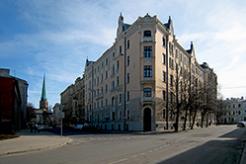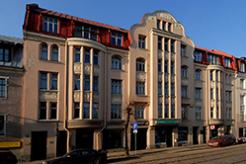




Author: Jānis Krastiņš, Dr. habil. arch.
Art Nouveau is the style of art prevailing in the late 19th century and early 20th century. It deserves special mention speaking about the architecture of Riga. When the historic centre of Riga was inscribed on the UNESCO World Heritage List, it was underlined that: “It is generally recognized that Riga has the finest collection of Art Nouveau buildings in Europe”[1].
Grosset’s apartment house with shops at Audēju iela 7 (1899, A. Aschenkampff and M. Scherwinsky; Picture 1) was one of the first Art Nouveau buildings in Riga. Its façade displays decorative idiom of Art Nouveau where compositions of embossed lines, circles and stylised plants form an elegant architectural image of the building. The intricate fenestration reflects the layout and location of rooms.
The apartment house with shops at Brīvības iela 55 (1900, architect W. Neumann using sketches by Berlin architect A. Giesecke; Picture 2) is explicitly rational in its expression and differs from the evenly decorated eclectic façades characteristic of the previous architectural style, yet its overall image implies historical continuity: its façades are crowned with several gables redolent of Dutch or German Renaissance architecture. This romantic artistic trend of Art Nouveau reflected the influence of German culture in Riga’s Art Nouveau architecture. This house forms a single ensemble with the building at Brīvības iela 68, located on the opposite corner of the intersection (1903, A. Schmaeling; Picture 3). The gables designed in the manner of romanticised Renaissance also overlook apartment houses at Krišjāņa Valdemāra iela 23 (1901, H. Scheel and F. Scheffel; Picture 4) and at Brīvības iela 110 (1902, J. Alksnis; Picture 5) etc.
In the earliest stage of Art Nouveau development architects tended to use ornaments to excess, often arranging architectural décor on the façades in a manner characteristic of the 19th century Eclecticism. Representatives of this variety of Eclectically Decorative Art Nouveau in Riga are the apartment houses at Smilšu iela 8 (1902; Picture 6) and Ģertrūdes iela 10/12 (1902; Picture 7) that were built to the designs by architects H. Scheel and F. Scheffel. The façades of those houses mostly exhibit Art Nouveau ornaments that had recently come into fashion then, i.e. different masks, sinuous lines, stylised plants, curvilinear shapes, lesenes hanging in groups of three or five where the middle one is longer, geometric patterns, etc. A number of well-known masters of architecture of Riga had designed buildings in the manner of Eclectically Decorative Art Nouveau, namely, K. Pēkšēns, R. H. Zirkwitz, A. Schmaeling, J. Alksnis, K. J. Felsko and others. The apartment house with shops at Brīvības iela 105 (1904, A. Witte; Picture 8) also possesses features of this stylistic variety.
More information will be available in the virtual exhibition, which will be established till April 2016.
[1]ICOMOS News (International Council on Monuments and Sites). – 1997. – December. – Vol. 7, No 3. – p. 25.